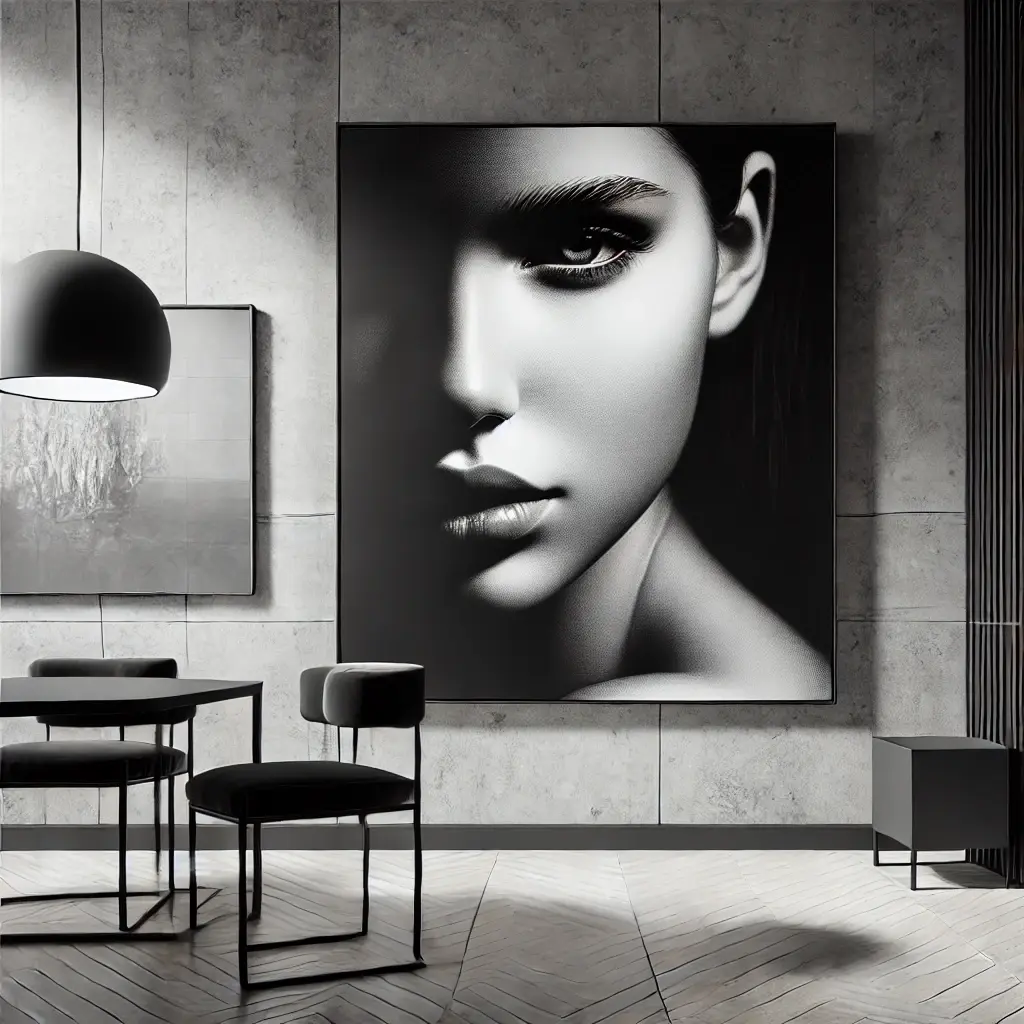Introduction
There’s a special allure in black and white abstract art that invites you to step closer, feel more deeply, and look beyond the surface. It strips away distractions, leaving only the essence of form, movement, and emotion. For many art lovers, this form of expression isn’t just a visual experience it’s an emotional one that resonates personally. If you’ve ever been mesmerized by a bold, monochrome piece, you’ve likely felt the power it has to communicate without the need for color. Join us as we delve into the fascinating history and evolution of black and white abstract art, a genre that captures both simplicity and complexity in ways that continue to captivate.
Table of Contents
1. The Origins of Black and White Abstract Art

Tracing the Roots of Black and White Abstract Art
Black and white abstract art has its roots in the early 20th century, a time when many artists began to rethink traditional methods and experiment with bold new ideas. Abstract art, at its core, defies literal representation; instead, it communicates through form, line, and movement. Monochrome abstraction art that exclusively uses shades of black, white, and grey was born from this revolutionary era, removing color from the equation to allow viewers to focus purely on shapes, patterns, and contrasts.
Historical Foundation
- Early Influences: In the early 1900s, artists like Kazimir Malevich and Wassily Kandinsky pioneered this abstract approach. Malevich’s “Black Square” (1915) is a pivotal piece, emphasizing form and shape while challenging the viewer’s imagination. Kandinsky, known for his abstract masterpieces, also used limited color schemes to evoke emotion and movement.
- The Role of Monochrome: By removing color, artists could highlight structural and formal elements. Black and white served as a pure canvas for exploring the boundaries of expression and communication, becoming a significant component in the art world’s evolution.
This movement laid the groundwork for future artists to explore and redefine what art could be, shifting the focus from what was being painted to how it was being painted.
2. Evolution and Influences Through Decades
A Decade-by-Decade Journey of Black and White Abstract Art

The journey of black and white abstract art is an ever-evolving story, with each decade introducing fresh perspectives, movements, and techniques. This form of expression has traversed cultural landscapes, war periods, and technological advances, adapting and evolving as it progressed through the years.
| Decade | Movement/Style | Key Figures | Techniques |
|---|---|---|---|
| 1920s-1940s | Constructivism, Dadaism | Kazimir Malevich, Jean Arp | Geometric forms, assemblage |
| 1950s-1970s | Abstract Expressionism | Franz Kline, Agnes Martin | Bold brushstrokes, high contrast |
| 1980s-Present | Minimalism, Digital Art | Sol LeWitt, Bridget Riley | Digital manipulation, precision |
1920s-1940s: Early Experiments in Abstraction
- Constructivism: Artists explored geometric, industrial shapes, emphasizing form over personal emotion.
- Dadaism: Known for challenging societal norms, Dadaists used black and white tones to highlight surreal and unexpected compositions.
1950s-1970s: The Rise of Abstract Expressionism
- Bold Brushwork and Intensity: Artists like Franz Kline used thick, black brushstrokes on white backgrounds, creating tension and movement.
- Minimalism’s Restraint: By the 1970s, minimalism introduced a more refined approach, focusing on simplified forms and serene compositions.
1980s-Present: The Digital Revolution and Beyond
- Digital Art: With advances in technology, artists began using digital tools to manipulate black and white imagery.
- Mixed Media: Today’s artists blend traditional techniques with digital enhancements, crafting intricate monochrome pieces that carry depth and texture.
Each era brought new interpretations, showing how black and white abstract art could evolve while retaining its core principles.
3. Techniques and Mediums in Black and White Abstract Art
Crafting Art Without Color: Techniques and Mediums
Creating depth, dimension, and emotion without color requires specific techniques and mediums. Black and white abstract artists have developed various methods that maximize the impact of monochrome.
Techniques Used
- Line and Brushstroke Variation: Artists play with line weight, creating areas of contrast that draw the eye and add dynamism to the composition.
- Texture and Layering: Different layers and textures create a tactile quality, even if the artwork is visual. Techniques like impasto and scraping add dimension.
- Contrast and Light Play: High contrast between black and white areas is essential for adding drama and intensity.
Popular Mediums
- Charcoal and Ink: These traditional mediums allow for intricate details and bold, dramatic effects.
- Acrylic and Oil on Canvas: Versatile and durable, these paints enable layering, bold strokes, and various textures.
- Digital Tools: Contemporary artists use digital software to create precise lines, overlays, and textures, merging modern techniques with classic styles.
These techniques make black and white abstract art more than just an absence of color it becomes a playground for innovation, pushing the boundaries of perception and imagination.
4. Iconic Black and White Abstract Artists and Their Works

Meet the Masters of Black and White Abstract Art
To appreciate black and white abstract art fully, it helps to know the artists who pioneered and transformed this genre. Here are some masters whose works continue to influence and inspire.
Pioneering Artists
- Kazimir Malevich: Known for “Black Square,” Malevich’s work questioned the traditional understanding of painting and explored pure geometric forms.
- Franz Kline: Kline’s dramatic black and white compositions, characterized by bold brushstrokes, brought raw emotion and energy to his abstract works.
Modern Contributors
- Ellsworth Kelly: His simple, monochromatic forms created a profound impact, emphasizing the beauty of minimalism.
- Bridget Riley: Riley’s optical art used black and white patterns to create illusions of movement, captivating viewers with rhythm and flow.
These artists showcased the potential of black and white, proving that creativity need not be limited by color.
5. The Significance and Appeal of Black and White Abstract Art Today

Why Black and White Abstract Art Remains Timeless
In modern times, black and white abstract art has an enduring appeal, fitting seamlessly into a variety of settings, from homes to offices and galleries.
Contemporary Appeal
- Versatile Aesthetic: Black and white art works with any design style, adding elegance without overwhelming a space.
- Visual Impact: Monochrome art demands attention, as the eye is drawn to contrasts, patterns, and shapes.
Psychological Impact
- Emotional Resonance: Studies show that black and white art can evoke deep emotional responses by engaging the viewer’s imagination. Without color to dictate a mood, viewers interpret the piece in their own unique way.
- Cognitive Engagement: Black and white art often feels more abstract, inviting viewers to spend more time decoding and interpreting it, fostering a mental engagement that is both personal and profound.
The simplicity of black and white abstract art keeps it relevant in a complex world, reminding us that beauty can exist in simplicity and restraint.
Conclusion
Black and white abstract art has a fascinating history and a timeless appeal that speaks to art lovers across generations. From its early beginnings to its ongoing evolution, this genre has shown that creativity isn’t limited by color; in fact, some of the most powerful artistic expressions can come from a monochrome palette. Next time you encounter a black and white abstract piece, pause and appreciate the artistry, the emotion, and the story woven into its stark contrasts. Embrace the simplicity and let it resonate with you, perhaps inspiring you to bring a piece of this timeless art form into your own space.
FAQs
Q: What is black and white abstract art?
A: Black and white abstract art is a form of art that uses only black and white colors to create non-representational compositions. It emphasizes contrast and light, often symbolizing dualities and completeness13.
Q: How does black and white abstract art contribute to interior design?
A: Black and white abstract art can easily integrate into various interior styles, from modern to classic, due to its timeless and versatile nature. It adds elegance and sophistication to spaces like living rooms or bedrooms12.
Q: What emotions or themes can black and white abstract art evoke?
A: This art form often evokes emotions related to balance, harmony, and the essence of nature. It can also represent abstract concepts or emotions without depicting realistic subjects26.
Q: Can black and white abstract art be combined with other colors?
A: While traditional black and white abstract art focuses on these two colors, some artists incorporate subtle hints of other colors to enhance contrast and visual interest1.
Q: How does black and white abstract art differ from other art styles?
A: Unlike figurative art, abstract art does not aim to represent reality. Instead, it focuses on the emotional and visual experience created by forms and colors34.
Q: Is black and white abstract art suitable for minimalist decor?
A: Yes, it is highly suitable. The simplicity and contrast of black and white abstract art can enhance a minimalist space by adding depth and creativity without clutter2.
Q: Can I create my own black and white abstract art?
A: Absolutely! Using materials like acrylic paint or ink, you can experiment with different techniques to create unique abstract pieces. Guides and tutorials are available for beginners5.
